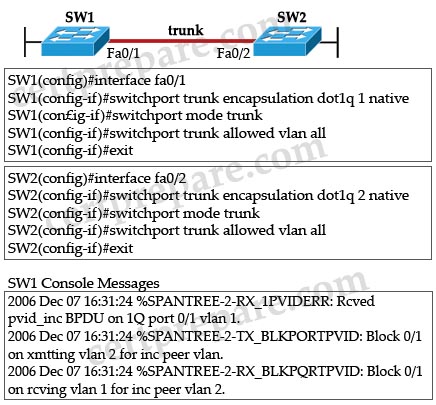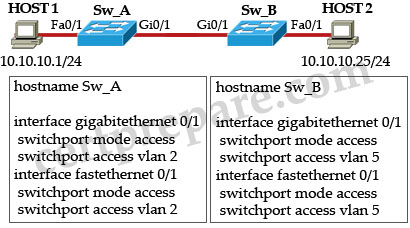VLAN Trunking Questions 3
Here you will find answers to VLAN Trunking Questions – Part 3
Question 1
Which configuration option will cause the link between two Cisco 3600 Series Multiservice Platforms to become a functional trunk?
A. switchport dynamic auto switchport dynamic auto
B. switchport access vlan 10
switchport mode dynamic desirable
C. switchport mode trunk switchport nonegotiate
D. Leave both ports with the default trunk settings.
Answer: D
Question 2
If you were to set up a VLAN trunk over a Fast Ethernet link on switch R1, which trunk mode would you set the local port to on R1 if you wanted it to respond to requests from its link partner (R2) and become a trunk?
A. Auto
B. Negotiate
C. Designate
D. Nonegotiate
Answer: A
Question 3
Which two statements are true about best practices in VLAN design? (Choose two)
A. Routing should occur at the access layer if voice VLANs are utilized. Otherwise, routing should occur at the distribution layer.
B. Routing may be performed at all layers but is most commonly done at the core and distribution layers.
C. Routing should not be performed between VLANs located on separate switches.
D. VLANs should be local to a switch.
E. VLANs should be localized to a single switch unless voice VLANs are being utilized.
Answer: B D
Question 4
You need to configure a new Company switch to support DTP. Which DTP switchport mode parameter sets the switch port to actively send and respond to DTP negotiation frames?
A. Access
B. Nonegotiate
C. Trunk
D. Dynamic desirable
E. Dynamic auto
Answer: D
Question 5
Refer to the exhibit.

The link between switch SW1 and switch SW2 is configured as a trunk, but the trunk failed to establish connectivity between the switches. Based on the configurations and the error messages received on the console of SW1, what is the cause of the problem?
A. The two ends of the trunk have different duplex settings.
B. The two ends of the trunk have different EtherChannel configurations.
C. The two ends of the trunk have different native VLAN configurations.
D. The two ends of the trunk allow different VLANs on the trunk.
Answer: C
Explanation
As you can see in the configuration of two switches, the native VLAN on SW1 is set to 1 while the native VLAN on SW2 is set to 2. This will cause a “native VLAN mismatch” error and it looks like this:
| #CDP-4-NATIVE VLAN_MISMATCH: Native VLAN mismatch discovered on Fa0/1 … |
Remember the native VLAN must match on both sides of the trunk link for 802.1Q; otherwise the link will not work. Also, Spanning Tree Protocol (STP) will place the port in a port VLAN ID (PVID) inconsistent state and will not forward on the link.
Question 6
A standalone wireless AP solution is being installed into the campus infrastructure. The access points appear to boot correctly, but wireless clients are not obtaining correct access. You verify that this is the local switch configuration connected to the access point:
interface ethernet 0/1
switchport access vlan 10
switchport mode access
spanning-tree portfast
mls qos trust dscp
What is the most likely cause of the problem?
A. QoS trust should not be configured on a port attached to a standalone AP.
B. QoS trust for switchport mode access should be defined as “cos”.
C. switchport mode should be defined as “trunk” with respective QoS.
D. switchport access vlan should be defined as “1”.
Answer: C
Explanation
The link between the switch and access point should be configured as trunked link and set the encapsulation on the switch port to dot1q:
Switch(config)#interface ethernet 0/1
Switch(config-if)#switchport mode trunk
Switch(config-if)#switchport trunk encapsulation dot1q
You can read more about how to configure the switch connected with an AP here: http://www.cisco.com/en/US/tech/tk722/tk809/technologies_configuration_example09186a0080665ceb.shtml.
Question 7
Which statement about the configuration and application of port access control lists is true?
A. PACLs can be applied in the inbound or outbound direction of a Layer 2 physical interface.
B. At Layer 2, a MAC address PACL takes precedence over any existing Layer 3 PACL.
C. When you apply a port ACL to a trunk port, the ACL filters traffic on all VLANs present on the trunk port.
D. PACLs are not supported on EtherChannel interfaces.
Answer: C
Explanation
When you apply a port ACL to a trunk port, the ACL filters traffic on all VLANs present on the trunk port. When you apply a port ACL to a port with voice VLAN, the ACL filters traffic on both data and voice VLANs.
With port ACLs, you can filter IP traffic by using IP access lists and non-IP traffic by using MAC addresses. You can filter both IP and non-IP traffic on the same Layer 2 interface by applying both an IP access list and a MAC access list to the interface.
Question 8
Given the configurations on SwitchA and SwitchB, which two statements are true? (Choose two)

A. The trunk is currently using the ISL trunking protocol
B. The trunk is currently using the 802.1q trunking protocol
C. By default, the trunk can only support one VLAN, and only that single VLAN is transmitted across the trunk
D. By default all VLANs will be transmitted across this trunk
E. By default, SwitchA and SwitchB’s FastEthernet 0/1 port will not generate DTP messages
Answer: B D
Explanation
The command “switchport trunk encapsulation dot1q” sets the trunking encapsulation format to IEEE 802.1Q-> B is correct.
By default all VLANs are allowed to transmitted across the trunk -> D is correct.
Note: The “switchport mode trunk” command enables trunking on the interface.
Question 9
Given the configurations on SwitchA and SwitchB, which statement is true?

A. The link is set to auto-negotiate trunking, and it will automatically become a trunk link unless configured otherwise
B. The link is a trunking link and by default all VLANs will be transmitted across this link
C. The link is prevented from generating DTP frames, turning the Negotiation of Trunking off
D. The link is not a trunk link so both interfaces must be on the same VLAN and only that single VLAN is transmitted across the link
Answer: D
Explanation
First you should understand how this topology works:
When PC1 sends traffic to Sw_A, Sw_A realizes that PC1 belongs to VLAN 2 so it will forward out of its Gi0/1 port which also belongs to VLAN 2. On the other side, Sw_B receives this frame coming from its Gi0/1 port so it believes this frame belongs to VLAN 5. Sw_B will forward this frame out of its Fa0/1 which belongs to VLAN 5, too -> PC1 & PC2 can communicate without further configuration provided that they are in the same subnet (so they don’t need a Layer 3 device).
Answer D is not clear when stating “both interfaces must be on the same VLAN”. We are not sure of “both interfaces” means “both interfaces on two switches (two Gi0/1 interfaces)” or “both interfaces on the same switch (Fa0/1 & Gi0/1 of Sw_A or Sw_B)”. If it means “both interfaces on two switches (two Gi0/1 interfaces)” then answer D is obviously incorrect as two PCs can still communicate even though they are not in the same VLAN (VLAN 2 & 5 in this case). If it means “both interfaces on the same switch” (must be on the same VLAN) then answer D is acceptable.
Answer C is interesting, it raises a question: will DTP be sent with the “switchport mode access” on an interface? From some official books the answer is “yes, DTP is still sent out of this type of port”. For example check Table 2.9 of this link: http://www.ciscopress.com/articles/article.asp?p=1416303&seqNum=2:
switchport mode access: Never trunks; sends DTP to help other side reach same conclusion
Although some other resources say DTP would not be sent on this type of port but we should follow the official books -> Answer C is incorrect.
Question 10
By default, which statement is correct when an IEEE 802.1Q trunk port receives an untagged frame?
A. The frame is considered in the native VLAN and forwarded to the ports associated with that VLAN
B. The frame is encapsulated and tagged as in the native VLAN
C. The frame is broadcast on all ports regardless of VLAN association
D. The frame is dropped
Answer: A


